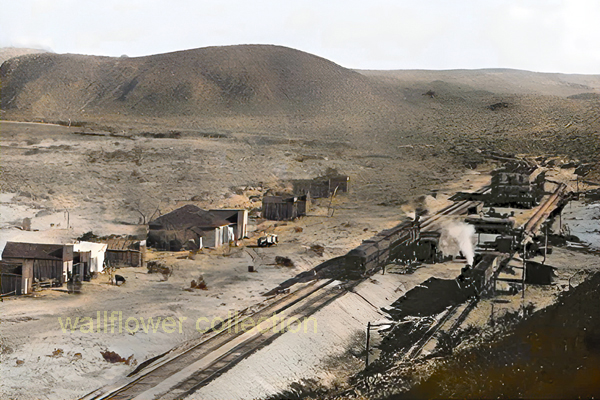The Santa Fe System
On the 7th day of July, 1866, an act passed Congress approving and sub- sidizing a new transcontinental line, starting from Springfield, Mo., "thence running by the most direct route to Albuquerque, N. M., thence to the head- waters of the Little Colorado, and then along tbe 35th parallel, north latitude, to the Colorado and thence to tide water."
Waterman - 1885
There was a race between this road and the Atchison, Topeka & Santa Fe, which had been organized in Kansas. In 1879 tne Atchison, Topeka & Santa Fe, the St. Louis & San Francisco and the Chicago & Alton Companies were combined for the purpose of building a joint line from Albuquerque to the Pacific coast. San Diego, undaunted by her many failures to secure rail- road facilities, at once set to work to induce this new line to make San Diego Harbor its terminus. Mainly through the efforts of the Kimball Brothers, who had invested heavily in San Diego and vicinity, two representatives of Atchison, Topeka & Santa Fe, Messrs. G. B. Wilbur and L. G. Pratt, of Boston, came to California and visited San Diego. These gentlemen were favor- ably impressed with the situation of San Diego, and also with the very liberal propositions made them by the Kimball Brothers and the citizens of San Diego generally.
San Diego offered "six thousand acres of land within the city, with a water front of one mile, $15,000 cash and 1,000 city lots; Messrs. Kimball, of the National Rancho, offered 10.000 acres, with another mile of water front; Tom Scott, of the defunct Texas & Pacific, agreed to deed to the Atchison, Topeka & Santa Fe Railroad Company, 4.500 acres of the land previously granted to him."
When San Bernardino heard that San Diego was to secure a visit from the railway men she was once more aroused. Mr. John Isaacs, who was then editor of the San Bernardino Times, and who took an active part in the campaign to secure the Santa Fe to San Bernardino, has furnished this statement of the work then done:
"On October 20, 1879, a meeting was held at the Court House, attended by the greater part of our leading business men, at which was discussed the advisability of trying to secure this new line. It was unanimously decided that every effort should be used to this end, and a delegation consisting of Mr. Fred Perris, then county surveyor, and John Isaacs, was appointed to meet the railway men when they should arrive, while Messrs. Anderson and Gregory were instructed to correspond with the railway officials in regard to their movements and extend an invitation to visit this valley. A committee to raise funds was also appointed, and by diligent labor secured S40.00, one of which was bogus.
With this sum the delegates started for San Diego, November 2d. The journey between the two cities was not a picnic in those days. There were no places of public entertainment along the road and few settlers. It was a three days' trip over rough and muddy roads. Upon arrival in San Diego it was found that Messrs. Wilbur and Pratt would not reach the city for five days. The committee, therefore, had ample time to spend its funds and to look over the lay of the land. They found that there were opposing interests at work. One party was bound that the road, if built at all. must come by the International boundary line that had been surveyed and much talked of some years previous to this. Another party with interests along the coast and in the northern part of the county, was equally determined that the road must come that way. The San Bernardino men soon found that their presence was not considered desirable by one party, at least, and a determined effort to prevent their meeting the railway men when they arrived, was made. Messrs. Wilbur & Pratt, however, declined the private hospitality that was pressed upon them, and went to the Horton House, where the San Bernardino delegation at last secured an appointment. At this interview there were present beside Messrs. Perris and Isaacs, Don Juan Foster, H. I. Willey and C. J. Cox. It lasted from 8 o'clock p. m. until i 130 a. m., and Mr. Perris furnished facts and gave topographical data which these gentlemen were totally unprepared for. At the close of the talk Mr. Wilbur said: "Gentlemen, if you will come for us in two weeks we will go up and see your country."
That promise was the turning point for San Bernardino, and from that moment we may date our railroad history.